- Venue
Stuart Hall Library
-
Time
6.30pm-8.30pm
-
Admission
Free
Recordings available at the bottom of the page.
Providing an overview of artists and organisations Alice Correia‘s research looks at key exhibitions such as Jagrati (1986-7); Fabled Territories (1989) and Transition of Riches (1993-4) and assess their remit, reception and legacies. Did these exhibitions seek to present a coherent artistic and cultural solidarity, or were contradiction and dissonance celebrated? To what extent have group shows of ‘Asian’ artists hindered our understanding of British Asian art within broader narratives of art history? How can the diversity of British-Asian identities and artistic practices found in these exhibitions be unravelled?
Although many Asian artists identified as ‘Black’ during this 1980s and early ‘90s, the project seeks to consider how the changing understanding of this term has helped and hindered scholars when attempting to articulate British-Asian art histories. How did the artistic and socio-political concerns of Asian artists converge and depart from those of the African diaspora? I will examine the specific role and participation of British-Asian artists in the politicised debates surrounding identity politics and belonging to Britain: Can Nilofar Akmut’s photographic mediations on the 1947 partition of the Indian subcontinent be regarded as reflecting British history? How might we understand Nina Edge’s work on the Bhopal disaster and corporate neo-imperialism today? What can we learn from Bhajan Hunjan’s painting commemorating the death of Balwant Kaur, murdered by her husband in Brent Asian Women’s Refuge?
A key artist emerging in the late 1980s and an exhibitor exhibitions including Jagrati, Nina Edge’s practice has included ceramics, textiles, batik, sculpture, installation and performance. Nina will present her work from the early period, important works such as Sold Down the River, a 1995 performance in Liverpool, described as ‘A Post Betrayal Intervention for a Post Industrial City’ and her contemporary socially engaged practice including a protest intervention at the Turner Prize drawing attention to how recent terror legislation contravenes human rights.
Biographies
Dr Alice Correia is an Art Historian and Curator. Her current research examines British-Asian diaspora art, the politics of representation and the legacies of Empire and Indian partition. She is a member of the Board of Trustees for the journal Third Text. Her doctorate in Art History is from the University of Sussex, and her thesis examined notions of Britishness, national identity and cultural diversity in contemporary art since 1980. In 2009 she curated the exhibition “Being British” at the Stephen Lawrence Gallery, University of Greenwich. Between 2012 and 2014 Correia was The Henry Moore Foundation Research Fellow at Tate.
Nina Edge originally trained as a ceramicist and is renowned for her collaborative projects involving local communities. She has written for publications including Third Text, International Journal of Art & Design Education and Feminist Art News. Exhibitions include Virtual Duality (Bluecoat, 1994), Mirage (ICA, 1995) Transforming the Crown (Studio Museum in Harlem, 1997), The Fifth Floor: Ideas Taking Space (Tate Liverpool, 2008), Turning FACT Inside Out (2013) as well as many site-specific and live works.



